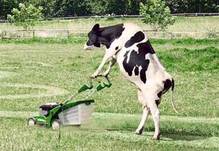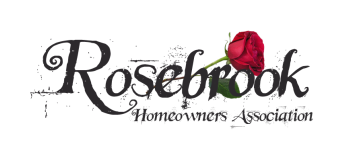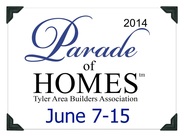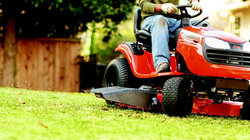
First the bad news: if you neglect Spring lawn care and any related concerns pertaining to your mower, you could end up paying for it the rest of the year. Now the good news: Spring lawn care doesn't entail nearly the amount of work that you'll have to invest in mowing alone throughout the summer months. In fact, most of you will need to implement only about half of the following ten tips for Spring lawn care depending upon your own unique circumstances.
Spring Lawn Care Tip #1: Raking
Raking will be your first task of Spring lawn care. Raking is for more than just removing leaves: it's for controlling thatch, too. A thatch build-up of more than 1/2 inch is considered excessive.
There's often another good reason for a Spring raking. As you survey your lawn in Spring, see if there are any matted patches in which the grass blades are all stuck together. This can be caused by a disease known as "snow mold." New grass may have difficulty penetrating these matted patches but a light raking will be sufficient to solve this problem.
Spring Lawn Care Tip #2: Check for Compaction
If your lawn is subjected to high levels of traffic year after year, it may eventually start to show signs of decline. In such cases, your lawn is probably suffering from compacted soil. For instance, the presence of moss signals compaction (among other things). You can get rid of it, but successful eradication begins with the recognition that moss shouldn't be treated as "just another weed". (See article on getting rid of moss).
Lawn aeration is the remedy for compaction. The good news is that lawn aerators can be rented at your local rental center. The bad news is that the experts recommend postponing lawn aeration until fall. But if, during your "spring lawn checkup," you become aware of compaction, at least you can plan on setting aside some time in the fall to take care of it.
Spring Lawn Care Tip #3: Liming
Besides compaction, the presence of moss plants also signals acidity. But grass likes a neutral pH. You can solve this problem by liming your soil. But don't expect a quick fix: the effects of liming are slow to take place.
First send a soil sample to your local county extension to determine the extent of your soil's acidity. The county extension will also be able to advise you on how much lime per square foot you'll need. Apply the lime using a fertilizer spreader.
If your lawn has been doing fine and shows no signs of suffering from acidity, don't apply lime. Liming is only a corrective measure, not a preventive measure. A soil that is too alkaline will also cause your lawn problems, so too much lime is as bad as not enough.
Spring Lawn Care Tip #4: Overseeding
Is your lawn riddled with bare patches due to dog spots, heavy traffic or neglect? If so, you may need to apply grass seed to fill in those bare patches. This solution is known as "overseeding lawns." Apply a slow-release nitrogen fertilizer when you overseed. Five weeks after the grass germinates, apply a quick-release nitrogen fertilizer.
However, Spring isn't the very best time for overseeding lawns. Fall is the preferred time when the new grass won't have to compete with crabgrass which is killed off by autumn frosts. So postpone overseeding until Fall, unless your situation is dire.
Spring Lawn Care Tip #5: Fertilizing
Lawns can be fertilized organically by using compost and mulching mowers. But for those who prefer chemical fertilizers, Scotts provides a schedule for fertilizing lawns. Many experts, however, recommend a lighter feeding in Spring and a heavier one in late Fall for the types of lawn grasses known as "cool-season grasses." Too much fertilizer in Spring can lead to disease and weed problems. And if you have, indeed, already fertilized in late Fall, your lawn is still "digesting" that fertilizer in Spring.
Spring Grass Care Tip #6: Applying Pre-emergent Herbicides
If you know that you have a problem with annual weeds and crabgrass, then fertilization in Spring should go hand in hand with the application of pre-emergent herbicides. As their name suggests, pre-emergent herbicides address weed control not "after the fact," but before their seedlings can even emerge. Pre-emergent herbicides accomplish this by forming something of a "shield" that inhibits seed germination. Don't undertake core aeration after applying pre-emergent herbicides: to do so would be to "puncture" this shield, thereby decreasing its effectiveness.
Crabgrass begins its assault on lawns in Spring when its seeds germinate and poses an additional problem when considering overseeding. So why not just begin by killing the crabgrass first with a pre-emergent herbicide? Because most pre-emergent herbicides work against not only weed seeds, but grass seeds as well! Therefore overseeding is incompatible with the application of most pre-emergent herbicides. If you must overseed in the spring, look for a product called, "Tupersan." Unlike other pre-emergent herbicides, Tupersan will not damage germinating lawn grass seed.
Spring Grass Care Tip #7: Applying Post-emergent Herbicides -- Or Pulling Weeds
Keep an eye out for the emergence of the perennial weed 'dandelion' during the Spring season. At the very least you'll want to snap off their flower stems before they produce seed. If you're more ambitious you can dig them out by the roots. Spraying dandelion weeds with a post-emergent herbicide is more effective in Fall rather than in Spring. If you do choose to spray, however, select an herbicide for broadleaf weeds.
Tip #8: Tuning Up Existing Lawn Mowers
Mowing the lawn all summer can be tiring enough, right? Why make it more difficult on yourself by putting up with a lawn mower that doesn't start up immediately? When a lawn mower is stubborn about starting up, that can be a sign that it needs a tuneup. Although it’s often possible to get by without one, it is recommended that you have a lawn mower tuneup each year. Don't put it off till summer or pay someone else to do it. Learn how to tune up a lawn mower yourself using the following resource and have your machine ready to go for summer: How to Tune Up Lawn Mowers
Tip #9: Buying a New Lawn Mower
Perhaps you're fed up with your old lawn mower. Or it's simply time for a change. This Q&A resource for consumers will help you decide on which type of lawn mower is best for you: The Best Lawn Mowers
Tip #10: Reviewing Lawn Mowing Strategies
If you would like to know more about how to assess the health of your lawn and the proper way to mow the lawn to maintain its health, Springtime is an excellent time to learn lawn mowing strategies. This Q&A resource will help you graduate from mindless lawn mowing to mowing with a purpose: Tips for Mowing Lawns
Spring Lawn Care Tip #1: Raking
Raking will be your first task of Spring lawn care. Raking is for more than just removing leaves: it's for controlling thatch, too. A thatch build-up of more than 1/2 inch is considered excessive.
There's often another good reason for a Spring raking. As you survey your lawn in Spring, see if there are any matted patches in which the grass blades are all stuck together. This can be caused by a disease known as "snow mold." New grass may have difficulty penetrating these matted patches but a light raking will be sufficient to solve this problem.
Spring Lawn Care Tip #2: Check for Compaction
If your lawn is subjected to high levels of traffic year after year, it may eventually start to show signs of decline. In such cases, your lawn is probably suffering from compacted soil. For instance, the presence of moss signals compaction (among other things). You can get rid of it, but successful eradication begins with the recognition that moss shouldn't be treated as "just another weed". (See article on getting rid of moss).
Lawn aeration is the remedy for compaction. The good news is that lawn aerators can be rented at your local rental center. The bad news is that the experts recommend postponing lawn aeration until fall. But if, during your "spring lawn checkup," you become aware of compaction, at least you can plan on setting aside some time in the fall to take care of it.
Spring Lawn Care Tip #3: Liming
Besides compaction, the presence of moss plants also signals acidity. But grass likes a neutral pH. You can solve this problem by liming your soil. But don't expect a quick fix: the effects of liming are slow to take place.
First send a soil sample to your local county extension to determine the extent of your soil's acidity. The county extension will also be able to advise you on how much lime per square foot you'll need. Apply the lime using a fertilizer spreader.
If your lawn has been doing fine and shows no signs of suffering from acidity, don't apply lime. Liming is only a corrective measure, not a preventive measure. A soil that is too alkaline will also cause your lawn problems, so too much lime is as bad as not enough.
Spring Lawn Care Tip #4: Overseeding
Is your lawn riddled with bare patches due to dog spots, heavy traffic or neglect? If so, you may need to apply grass seed to fill in those bare patches. This solution is known as "overseeding lawns." Apply a slow-release nitrogen fertilizer when you overseed. Five weeks after the grass germinates, apply a quick-release nitrogen fertilizer.
However, Spring isn't the very best time for overseeding lawns. Fall is the preferred time when the new grass won't have to compete with crabgrass which is killed off by autumn frosts. So postpone overseeding until Fall, unless your situation is dire.
Spring Lawn Care Tip #5: Fertilizing
Lawns can be fertilized organically by using compost and mulching mowers. But for those who prefer chemical fertilizers, Scotts provides a schedule for fertilizing lawns. Many experts, however, recommend a lighter feeding in Spring and a heavier one in late Fall for the types of lawn grasses known as "cool-season grasses." Too much fertilizer in Spring can lead to disease and weed problems. And if you have, indeed, already fertilized in late Fall, your lawn is still "digesting" that fertilizer in Spring.
Spring Grass Care Tip #6: Applying Pre-emergent Herbicides
If you know that you have a problem with annual weeds and crabgrass, then fertilization in Spring should go hand in hand with the application of pre-emergent herbicides. As their name suggests, pre-emergent herbicides address weed control not "after the fact," but before their seedlings can even emerge. Pre-emergent herbicides accomplish this by forming something of a "shield" that inhibits seed germination. Don't undertake core aeration after applying pre-emergent herbicides: to do so would be to "puncture" this shield, thereby decreasing its effectiveness.
Crabgrass begins its assault on lawns in Spring when its seeds germinate and poses an additional problem when considering overseeding. So why not just begin by killing the crabgrass first with a pre-emergent herbicide? Because most pre-emergent herbicides work against not only weed seeds, but grass seeds as well! Therefore overseeding is incompatible with the application of most pre-emergent herbicides. If you must overseed in the spring, look for a product called, "Tupersan." Unlike other pre-emergent herbicides, Tupersan will not damage germinating lawn grass seed.
Spring Grass Care Tip #7: Applying Post-emergent Herbicides -- Or Pulling Weeds
Keep an eye out for the emergence of the perennial weed 'dandelion' during the Spring season. At the very least you'll want to snap off their flower stems before they produce seed. If you're more ambitious you can dig them out by the roots. Spraying dandelion weeds with a post-emergent herbicide is more effective in Fall rather than in Spring. If you do choose to spray, however, select an herbicide for broadleaf weeds.
Tip #8: Tuning Up Existing Lawn Mowers
Mowing the lawn all summer can be tiring enough, right? Why make it more difficult on yourself by putting up with a lawn mower that doesn't start up immediately? When a lawn mower is stubborn about starting up, that can be a sign that it needs a tuneup. Although it’s often possible to get by without one, it is recommended that you have a lawn mower tuneup each year. Don't put it off till summer or pay someone else to do it. Learn how to tune up a lawn mower yourself using the following resource and have your machine ready to go for summer: How to Tune Up Lawn Mowers
Tip #9: Buying a New Lawn Mower
Perhaps you're fed up with your old lawn mower. Or it's simply time for a change. This Q&A resource for consumers will help you decide on which type of lawn mower is best for you: The Best Lawn Mowers
Tip #10: Reviewing Lawn Mowing Strategies
If you would like to know more about how to assess the health of your lawn and the proper way to mow the lawn to maintain its health, Springtime is an excellent time to learn lawn mowing strategies. This Q&A resource will help you graduate from mindless lawn mowing to mowing with a purpose: Tips for Mowing Lawns




 RSS Feed
RSS Feed